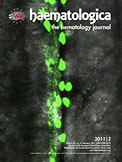Balgobind BV, Van den Heuvel-Eibrink MM, De Menezes RX, Reinhardt D, Hollink IH, Arentsen-Peters ST, van Wering ER, Kaspers GJ, Cloos J, de Bont ES, Cayuela JM, Baruchel A, Meyer C, Marschalek R, Trka J, Stary J, Beverloo HB, Pieters R, Zwaan CM, den Boer ML. Haematologica. 2011 Feb;96(2):221–30. Epub 2010 Oct 22. IF: 6.416

Abstract:
BACKGROUND: Pediatric acute myeloid leukemia is a heterogeneous disease characterized by non-random genetic aberrations related to outcome. The genetic subtype is currently detected by different diagnostic procedures which differ in success rate and/or specificity. DESIGN AND METHODS: We examined the potential of gene expression profiles to classify pediatric acute myeloid leukemia. Gene expression microarray data of 237 children with acute myeloid leukemia were collected and a double-loop cross validation approach was used to generate a subtype-predictive gene expression profile in the discovery cohort (n = 157) which was then tested for its true predictive value in the independent validation cohort (n = 80). The classifier consisted of 75 probe sets, representing the top 15 discriminating probe sets for MLL-rearranged, t(8;21)(q22;q22), inv(16)(p13q22), t(15;17)(q21;q22) and t(7;12)(q36;p13)-positive acute myeloid leukemia. RESULTS: These cytogenetic subtypes represent approximately 40 % of cases of pediatric acute myeloid leukemia and were predicted with 92% and 99% accuracy in the discovery and independent validation cohort, respectively. However, for NPM1, CEBPA, MLL(-PTD), FLT3(-ITD), KIT, PTPN11 and N/K-RAS gene expression signatures had limited predictive value. This may be caused by a limited frequency of these mutations and by underlying cytogenetics. This latter is exemplified by the fact that different gene expression signatures were discovered for FLT3-ITD in patients with normal cytogenetics and in those with t(15;17)(q21;q22)-positive acute myeloid leukemia, which pointed to HOXB-upregulation being specific for FLT3-ITD(+) cytogenetically normal acute myeloid leukemia. CONCLUSIONS: In conclusion, gene expression profiling correctly predicted the most prevalent cytogenetic subtypes of pediatric acute myeloid leukemia with high accuracy. In clinical practice, this gene expression signature may replace multiple diagnostic tests for approximately 40 % of pediatric acute myeloid leukemia cases whereas only for the remaining cases (predicted as ‘acute myeloid leukemia-other’) are additional tests indicated. Moreover, the discriminative genes reveal new insights into the biology of acute myeloid leukemia subtypes that warrants follow-up as potential targets for new therapies.
-mk-